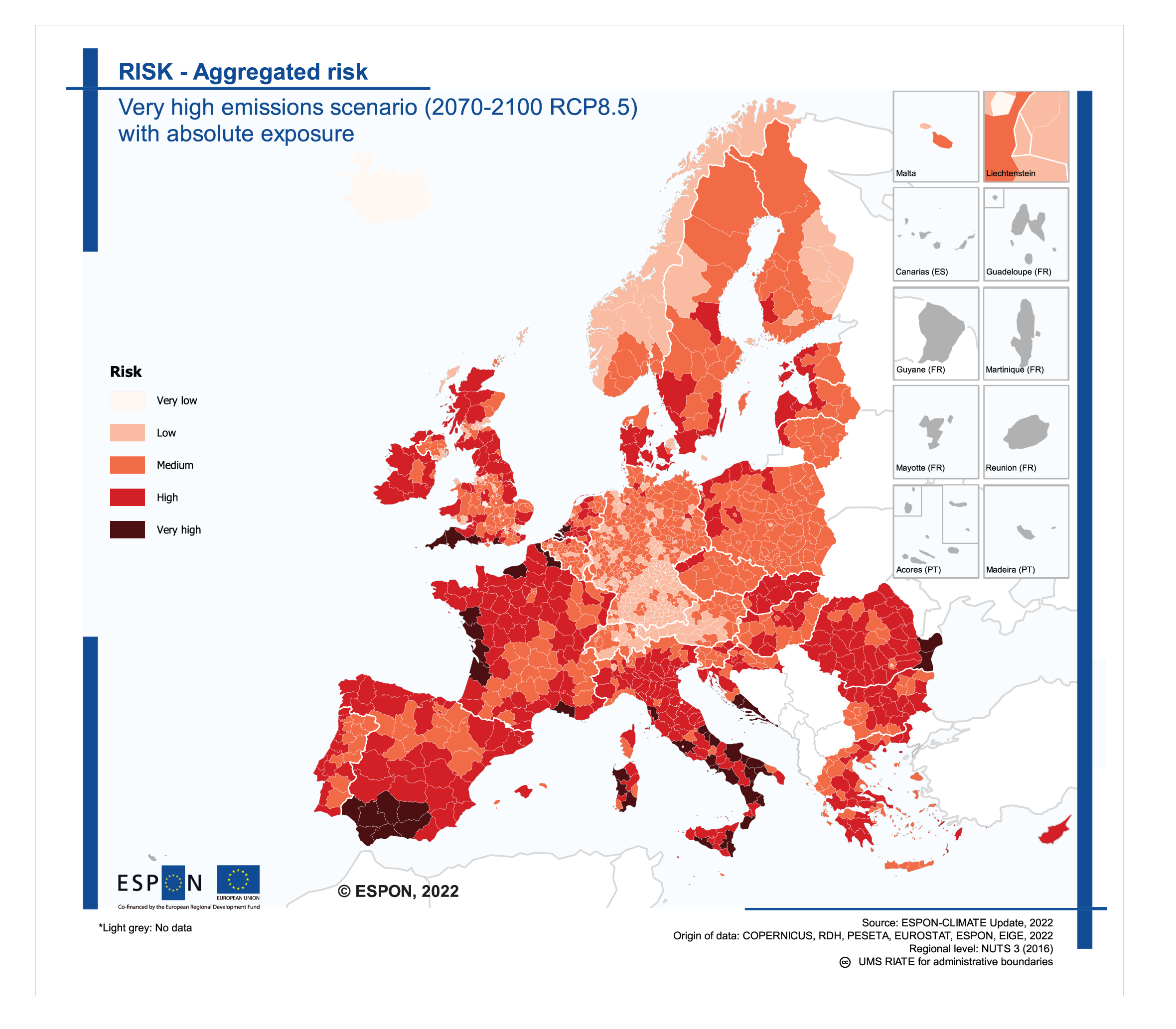Objective
The TAP Natural-Based Adaptation to Climate Change aims to support efforts to adapt to climate change by promoting nature-based solutions (NbS). It will achieve this by providing evidence on the territorial impact of climate change and the effectiveness of NbS in different areas. The TAP also seeks to improve policymakers' capacity to integrate NbS into territorial development strategies.
Focus
The TAP Natural-based adaptation to climate change focuses on the territorial dimension of climate adaptation using NbS. It will develop indicators to measure climate vulnerability and the effectiveness of NbS interventions. The research will also examine how NbS can contribute to other EU policy goals, such as nature conservation, while strengthening territorial cohesion. Finally, the TAP will explore how best to mobilize funding to support NbS implementation.
Learn more about the TAP Nature based adaptation to Climate Change
Context
Climate change is acknowledged to be the most urgent global challenge of our age which must be very rapidly addressed through cross-sectoral adaptation measures at all scales of governance. A recent report by the World Meteorological Organisation highlighted that temperatures in Europe have increased at more than twice the global average over the past 30 years at a rate of about +0.5 °C per decade—the highest of any continent in the world—and, regardless of future levels of climate heating, temperatures will continue to rise at a rate exceeding global mean temperature changes. A much warmer climate cannot be avoided anymore, and we need to be better prepared to cope with the inevitable effects of climate heating, adapting our ways of living.
Adaptation is therefore now a top priority for the European Union (EU) across all policy spheres. For example, a European Climate Risk Assessment (EUCRA) is currently being prepared by DG CLIMA and is due to be published in Spring 2024. The purpose of this assessment is to develop a comprehensive pan-European understanding of current and future direct and indirect climate heating impacts and risks relating to environment, economy and wider society, such as extreme rainfalls, droughts, increased intensity and frequency of storms, rising sea levels, flooding and mudslides, all of which have the potential for very serious social, economic and environmental consequences.
The ESPON CLIMATE project (2022) produced evidence to show that climate change is already causing numerous adverse impacts on the European territory and is having, and will continue to have, territorially asymmetric consequences. The ESPON TITAN project has further developed methodologies to analyse the territorial distribution patterns of the economic impacts of these climate risks. These studies conclude that peripheral regions, particularly in southern Europe, are being hit first and hardest due to higher vulnerability and reduced adaptive capacities.
The territorial unevenness of unfolding climate related risks has the potential to place significant strains on EU cohesion in the coming decades. The adverse effects of climate heating are of course not limited to within national borders and will also intersect with other socioeconomic, environmental, political and demographic challenges. Furthermore, it is estimated that by 2050, 80% of the world’s population will live in cities. This means cities and their regions will be at the forefront of the necessity to adapt to climate heating. As the warming trends continue, it will profoundly affect societies, economies and ecosystems in multiplex ways which cannot be fully known, including critical infrastructure, industry, public services, agriculture, migration patterns etc, requiring a renewed integrated territorial governance emphasis on adaptation.
Accordingly, the European Commission has launched a specific ‘Mission on Adaptation to Climate Change’ which focuses on supporting regions, cities and local authorities in their efforts to adapt to these evolving impacts. This TAP, ‘Nature-Based Adaption to Climate Change’, aims to support these governance efforts by providing territorial evidence on climate-related vulnerability and risks, and to deliver evidence-informed policy options for regions and cities to better adapt to its impacts in response to their new territorial development realities, and with the aim of achieving social cohesion, human wellbeing and healthy ecosystems.
Challenges specific to the TAP theme
It is clear that European citizens are facing a complex array of grave challenges as a consequence of climate heating, including degradation and loss of natural capital such as clean air, water and soils, related human health issues and losses caused by an alarming increase in weather related disasters. Alongside the urgent need for rapid mitigation, adaptation therefore also now has a very high priority in the EU policy scene with the flagship European Green Deal seeking to significantly step up the efforts on climate-proofing, resilience-building, prevention and preparedness as part of the transformational changes needed to adapt to climate heating and to help ongoing efforts to limit it.
A key outcome of the UN Climate Change Conference COP26 was an enhanced focus on Nature-based Solutions (NbS) to manage climate risks. The European Commission defines NbS as:
“Solutions that are inspired and supported by nature, which are cost-effective, simultaneously provide environmental, social and economic benefits and help build resilience. Such solutions bring more, and more diverse, nature and natural features and processes into cities, landscapes and seascapes, through locally adapted, resource-efficient and systemic interventions.”1
There is now an emerging global consensus around the imperative for NbS which encompasses a wide range of integrated approaches and holistic actions to address societal and biodiversity challenges, together with mitigation goals, while also benefitting human wellbeing, economy and nature. In terms of climate heating, this implies working within and mimicking nature’s capacity to absorb greenhouse gases, including sustainable land-use practices that can remove carbon from the atmosphere as a mitigation measure while also providing adaptive capacity to reduce climate risks, such as flooding, heat stress and wildfires.
The UN Biodiversity Conference COP15 in December 2022 also concluded with the landmark “Kunming-Montreal Global Biodiversity Framework” agreement to protect 30% of the planet’s lands, coastal areas and inland waters by 2030, alongside reducing to near zero the loss of ecosystems of high ecological integrity. The effect of both these international conventions is a seismic transformation in how we manage territories with a prioritisation of a restorative approach to ecosystems.
At the EU level, the Habitats Directive and its established network of Natura 2000 sites has of course long been the cornerstone of European nature conservation. Likewise, the Farm to Fork Strategy is now at the heart of the European Green Deal and its Biodiversity Strategy for 2030, highlighting the critical importance of jointly tackling climate heating and biodiversity in tandem so as to halt and reverse habitat loss by transforming our food systems, natural forest cover; land, wetlands, water and sea use; as well as energy, urban and industrial systems.
In recognition of the urgency of responding and adapting to the climate and biodiversity crises, the European Commission has also recently proposed a Nature Restoration Law which will be binding on EU member states so as to help:
- increase biodiversity;
- secure the services nature does for free, like cleaning our water and air, pollinating crops and protecting us from floods;
- limit global warming to 1.5°C, including through carbon sequestration; and,
- build up Europe’s resilience and strategic autonomy, preventing natural disasters and reducing risks to food security.
Similarly, the EU Strategy on Adaptation to Climate Change (2021) also aims to build a climate adaptive society by improving knowledge of climate impacts and adaptation solutions through stepping up adaptation planning and climate risk assessments. The strategy pursues three objectives of smarter, systemic and faster adaptation, and proposes a range of actions including more and better climate loss data and local adaptation actions. Notably, the strategy places a particular emphasis on NbS for disaster risk prevention so as to provide a ‘triple dividend’ of adaptation i.e., (i) avoiding future human, natural and material losses; (ii) generating economic benefits by reducing risks, increasing productivity, and stimulating innovation; and (iii) providing social, environmental and cultural benefits. In support of these efforts, the European Commission has further recently proposed introducing a system of ‘ecosystem accounts’ to assist as decision-making tools for integrated policy development.
Other EU policies which take a similar holistic NbS perspective include, for example, the Circular Economy Action Plan, Urban Agenda/New Leipzig Charter,Bioeconomy Strategy, Sustainable Development Goals (SDGs) and New European Bauhaus, all of which aim to provide a bridge between the world of science and technology, and art and culture, so as to systematically transform societies for the better through co-creation across disciplines, in harmony with nature, the environment and our planet.
However, even though all of these overlapping policy priorities coincide within territories, their visibility in conventional territorial development policy is often limited, unprioritised and subordinated to short-term economic goals, particularly in relation to capital-intensive physical infrastructure. Furthermore, adaptation measures are usually defined by sector, with little awareness of how other sectors could also contribute to the co-achievement of adaptation objectives in a more integrated, efficient and effective manner.
NbS, for example, can contribute to significant regeneration and upgrading of urban built environments whilst delivering multiple other benefits in terms of energy reduction in mobility, wastewater treatment, heating and cooling. Previous ESPON research, such as GRETA, for example, has shown that the benefits of NbS, or ‘Green Infrastructure’, such as parks, nature reserves, urban forests and green roofs are significant for bettering adaptive capacity to climate heating, including attenuating flooding, mitigating urban heat island effects etc. Green Infrastructure can therefore provide multiple, interlocking ecological, social and economic benefits to improve the liveability, health, wellbeing and sustainability of places.
A major barrier to the deployment of NbS, however, remains the insufficient understanding amongst policy stakeholders of the way natural ecosystems function, how appropriate adaptive measures can be identified, and their benefits quantified, all of which often results in an underused potential for NbS in territorial development policy. This was confirmed during the stakeholder consultation for this TAP whereby it was acknowledged that there was a large, and sometimes overwhelming, volume of research, data and policy guidance available, but this is not filtering through to policy action on the ground. Furthermore, policy sectors like finance, energy, health and social services have so far not been integrated sufficiently in NbS planning, despite important interrelations.
Purpose and policy use of the TAP
In recognition of the clear policy priority for climate adaption, described above, the purpose of this TAP is to mobilise ESPON evidence to help sustain NbS policy actions in support of Cohesion Policy’s objectives of a greener, low-carbon future alongside the priorities of the Territorial Agenda 2030 for a just and green Europe.
This TAP will also support the objective of ‘a Europe closer to citizens’ by helping to strengthen integrated territorial development, policy co-creation and local initiatives. For example, one concrete, practical programme that this TAP could support is the EU Covenant of Mayors for Climate & Energy which brings together thousands of local governments that wish to secure a better future for their citizens, including through carrying out risk and vulnerability assessments for determining the climate hazards that could pose a potential threat or harm to people, property, livelihoods and the environment on which they depend, and as critical information for policy decision-making.
As opposed to a strong focus on technological and physical infrastructure solutions (so called, ‘grey’ options), this TAP will instead concentrate on the potential for managing climate risks through ‘green’ and ‘blue’ options, which focus on NbS in land, water and marine areas. Green and blue adaptation measures tend to have a very strong territorial dimension, including in their overlap with other EU policy domains and the prospect for significant territorial conflicts with other sectors, necessitating an enhanced cross-sectoral, multi-level and integrated territorial governance perspective. In this objective, this TAP will therefore aim to support policy through:
- Developing indicators to measure and monitor climate adaptation in differing types of territories, sensitive to variegated typologies and territorial vulnerabilities and risks, including their potential for use in future multi-threat risk impact modelling and scenario analysis assessments;
- Comparative studies, transferrable to policymaking, aimed at identifying the key differentiated territorial impacts of climate heating, and the challenges and opportunities that may affect territorial adaptation to these impacts, including monitoring the effectiveness of adaptation measures (e.g., Societal Readiness Levels) and their implications for wider EU cohesion goals;
- Better understanding of the role that NbS policy options can play in climate heating adaptation and in achieving other allied EU policy goals through an integrated territorial development perspective, simultaneously providing environmental, social and economic benefits;
- Strengthening the capacities, skills and agency of policy makers at all levels of governance, and across policy sectors and borders, to incorporate NbS climate adaptation in their programming and policy making processes, and to bring more, and more diverse, nature and natural features and processes into the territorial governance of cities, landscapes and seascapes;
- Promoting cross-sectoral policy networking and involvement of civil society actors in cross-cutting, co-created actions in relation to adaptation to the impacts of climate heating, transforming territories to adjust to climate risks and as a possible means for overcoming potential inter-local and inter-sectoral conflicts; and,
- Supporting different territorial policy actors in planning, managing, implementing, monitoring and evaluating NbS to ensure territories’ adaptive capacities can be cost-effectively and fully utilised through locally adapted, resource-efficient and systemic interventions.
Strategic orientation of the TAP
The following strategic considerations shall be considered for this TAP theme:
- Filling gaps in scientific evidence that could support a better understanding of the territorial aspects of the challenges and opportunities represented by climate adaptation, specifically NbS, including through developing monitoring indicators;
- Providing evidence for better informed policy decisions on climate adaption that are inspired and supported by nature, which are cost-effective and concurrently provide environmental, social and economic benefits;
- Developing knowledge and transferring best-practice that can help jointly achieve other EU policy goals (e.g., nature conservation) and enhance their policy-relevance for climate adaptation, and vice versa, through locally adapted, resource-efficient and systemic interventions; and,
- Identify how Cohesion Policy funding, alongside other funding sources for policy implementation and research, can be best mobilised and integrated to rapidly support NbS for climate adaptation.
Stakeholder Consultation
The TAP was subject to extensive stakeholder consultation, including exchanges with high-level organisations such as DG REGIO Unit G1 (Smart and Sustainable Growth), DG Research & Innovation (Climate and Planetary Boundaries (RTD.B3)), European Environment Agency, European Central Bank etc. together with research institutions/universities and Monitoring Committee members. Over twenty detailed written submissions were received. In addition, four well attended Advisory Panels were organised, which provided valuable feedback demonstrating a strong policy interest in this TAP.
As outlined above, there is a very significant amount of ongoing work by many actors on this theme, including quantitative pan-European research in data and indicators as well as initiatives for qualitative best-practice transfer. Accordingly, activities under this TAP will require detailed consideration and consultation to maximise their impact, while avoiding overlaps and duplication.
Discover content for TAP
Filters10 results






